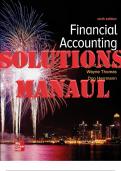Exam (elaborations)
Financial Accounting 6th Edition By Spiceland,Thomas, Herrmann_SOLUTIONS MANUAL
TEST BANK for Financial Accounting 6th Edition by David Spiceland, Wayne Thomas and Don Herrmann. TABLE OF CONTENTS: Chapter 1: A Framework for Financial Accounting Chapter2: The Accounting Cycle: During the Period Chapter3: The Accounting Cycle: End of the Period Chapter4: Cash and Inte...
[Show more]



